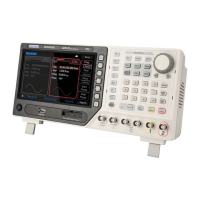User Manual 20
Press Symmetry softkey to highlight. At this point, use the numeric keyboard to input the
symmetry value and select the unit "%" from the pop-up unit menu or use the direction keys and
knob to modify the current value. For the input method of symmetry value, refer to the introduction
in "Parameter Setting Method".
The setting range of symmetry is from 0% to 100% and the default is 50%.
2.2.9 Set the Pulse Parameters
To output a pulse, users need to set the "Width/Duty", "Leading" and "Trailing", in addition to the
basic parameters (such as the frequency, amplitude, DC offset voltage, high level, low level and
align phase) introduced above.
Pulse Width/Duty Cycle
Pulse width is defined as the time from the 50% threshold of a rising edge amplitude to the 50%
threshold of the next falling edge amplitude as shown in the figure above.
The settable range of the pulse width is limited by the "Minimum Pulse Width" and the "Pulse
Period" (for the ranges of the "Minimum Pulse Width" and "Pulse Period", please refer to "Signal
Characteristics" in "Specifications"). The default value is 100μs.
1.
2. - Minimum Pulse Width × 2
Pulse duty cycle is defined as the percentage that the pulse width takes up in the whole pulse

